Whenever I'm driving and see a Herb Chambers billboard, I smile.

At this point, I can recognize the short, humorous, memorable ad copy as a Herb ad without even needing to see the brand name.
And, after years of seeing those ads, I feel like I know the Herb brand, and can describe it like an old friend: He's funny, likes a good pun, and doesn't take himself too seriously.
Now that's the power of brand voice: the power to make your brand come to life.
Consumers prefer brands with strong, unique personalities. In Sprout Social's 2020 Index, for instance, 40% of consumers listed memorable content as a factor that helps brands stand out on social; 33% voted for distinct personality; and 32% said compelling storytelling.
What do memorable content, distinct personality, and compelling storytelling have in common? Brand voice.
Here, let's explore what brand voice is, and examples of some of the most powerful brand voices today. Plus, how you can create your own.
What is brand voice?
When a friend calls you, consider — beyond the name that appears on caller ID — how do you know it's her?
More likely than not, you can deduce this information from how she speaks. The common phrases she uses, how she tells a story, her tone and inflection, and even what information she chooses to include (and exclude) in a given sentence all highlight her unique voice and personality.
Alternatively, think about the last time you chatted with a stranger. In mere minutes, I bet you start to get a sense for their personality. Through a brief conversation, you can start to deduce whether they're outgoing or shy, serious or funny, and more.
Ultimately, a person's voice is synonymous with their personality, as it relates to how they communicate.
And brand voice isn't much different.
Brand voice is the personality your brand takes on in all of its communications.
Brand voice is a critical factor for creating consistency across communication channels, regardless of who creates the content. For instance, brands with strong voice will sound the same on social media, email communications, and blog posts — even if three different teams create content for those channels.
Good brand voice makes your brand stand out from the noise, and helps consumers remember and relate to your brand. This, in turn, creates stronger brand loyalty.
Plus, brand voice can help attract new prospects before they even learn about your product or services.
For instance, consider the humor used in MoonPie's social posts:
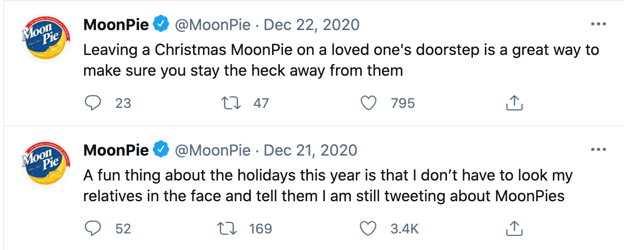
Before I'd even purchased a MoonPie for the first time, I followed them on Twitter. Why? Because I liked the brand's voice — it made me laugh, and felt relatable.
Of course, a brand voice doesn't have to be funny to be powerful. Other powerful brand voices can be inspiring, emotional, bold, casual, formal, poetic, or direct.
To see this in-action, let's take a look at some impressive examples of brand voice, next.
Brand Voice Examples
1. Spotify
Whether you're watching a TV ad, driving past a billboard, or scrolling Spotify's social accounts, you'll see consistently funny, edgy, direct, and concise language used to develop Spotify's brand voice.
For instance, take a look at this video, which is part of a Spotify advertisement campaign from 2019, 'Let the Song Play':
As you can see, Spotify doesn't take itself too seriously. The ad makes fun of people who get so emotionally-invested in a song that they won't resume their plans until the song ends.
You'll see a similar brand voice play out on Spotify's social channels. On its Twitter account, for instance, the brand often posts tweets related to new music in a casual, friendly manner, like this one:

If I were to describe Spotify's brand voice as a person, I'd say she's witty, sarcastic, and up-to-date on today's pop culture references. You'll see that personality play out across all of Spotify's communication channels.
2. Mailchimp
For this next example, we can look at Mailchimp's Content Style Guide to derive important information related to Mailchimp's brand voice.
In the Style Guide, Mailchimp writes, "We want to educate people without patronizing or confusing them. Using offbeat humor and a conversational voice, we play with language to bring joy to their work … We don't take ourselves too seriously."
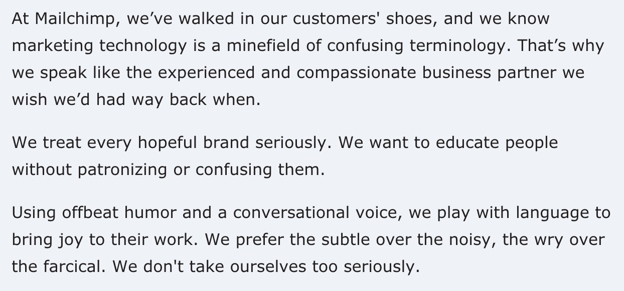
Even in the Style Guide, you can hear Mailchimp's brand voice shine through. The brand consistently achieves a conversational, direct, playful voice in all its content.
For instance, in this blog post, the brand writes about various "highly unscientific personas", including the fainting goat, which links out to a hilarious video. "When startled, its muscles stiffen up and it falls right over", strikes the appropriate casual tone that is a staple of the brand's voice.
As you can see from this example, you can evoke brand voice in subtle yet effective ways. If the blogger had instead written, "If a goat is scared, it becomes nervous. The animal's muscles contract and it faints as a result", the writer would've evoked a voice more aligned with a scientific journal than Mailchimp.
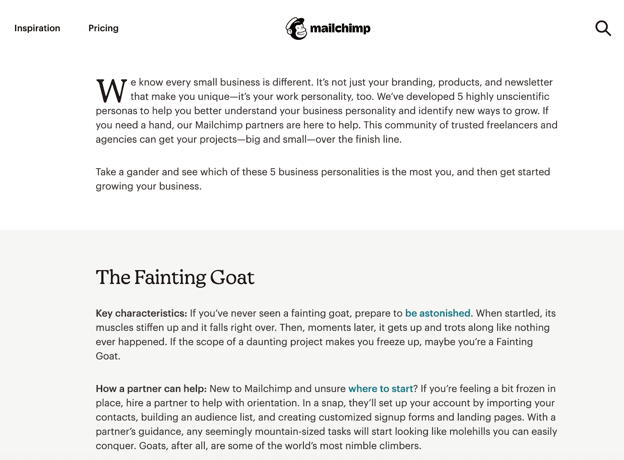
3. Fenty Beauty
On the About Us page for Rihanna's beauty company, it says, "Before she was BadGalRiRi: music, fashion and beauty icon, Robyn Rihanna Fenty was a little girl in Barbados transfixed by her mother’s lipstick. The first time she experienced makeup for herself, she never looked back. Makeup became her weapon of choice for self-expression."
It's clear, even just through this short snippet, that Fenty Beauty's voice is bold, direct, and poetic, using language like "transfixed by her mother's lipstick" and "her weapon of choice for self-expression". However, the tone is also undeniably casual — the way you might talk to your best friend.
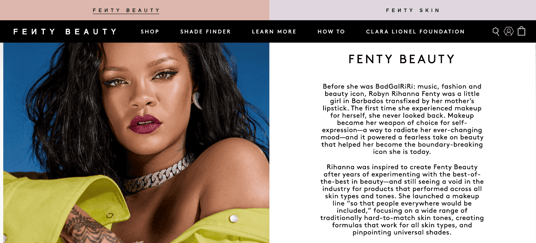
You'll see this voice play out across all Fenty social channels, including this YouTube video description: "The blur is REAL! Rihanna wanted to create a light coverage, easy-to-apply, flexible skin tint that instantly evens out your complexion and gives a flattering blurred effect. Eaze Drop, paired with Fenty Skin's HYDRA VIZOR for added SPF protection, is the perfect combo for a natural, no-makeup makeup look, or for when you want to look effortlessly put together."
The first statement, "The blur is REAL!" — along with phrases like "No-makeup makeup look", and the shortening of the word "combination" — all evoke a sense of friendliness. The brand voice matches its target audience perfectly: youthful millennials and Gen-Zers who care about makeup as an opportunity for authentic expression.
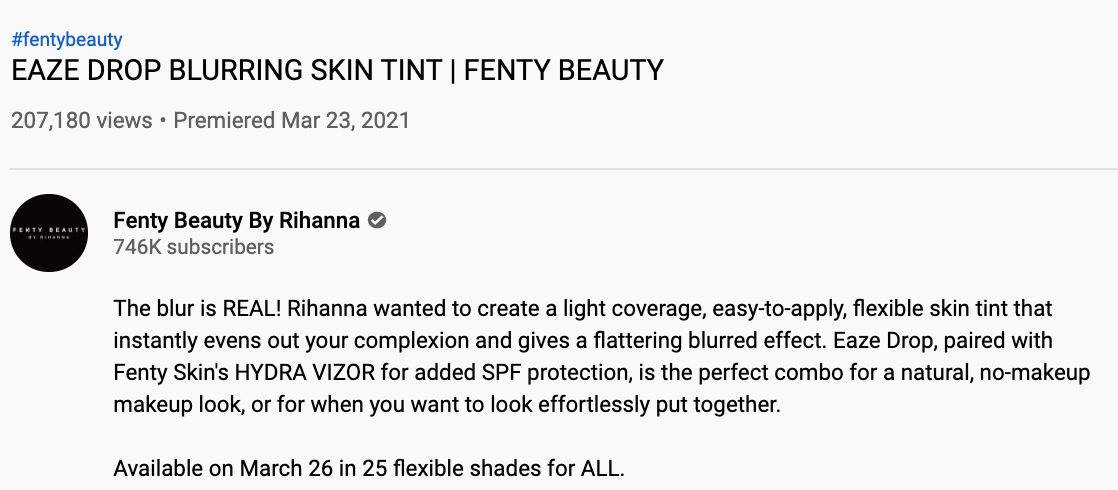
4. Clare Paint
Clare, an online paint site, has created a mature, spirited, and cheerful brand voice to evoke a breezy, girl-next-door feel to their branded content.
For instance, consider the title of one of their recent blog posts, "6 Stylish Rooms on Instagram That Make a Strong Case For Pink Walls".
The post — which uses phrases like "millennial pink", "pink walls have obvious staying power", and "designers and DIY enthusiasts alike have embraced the playful shade with open arms" — uses a friendly, chic, professional tone to relate to its readers while simultaneously demonstrating the brand's home decor expertise.
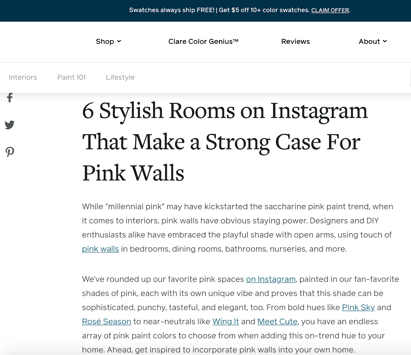
This voice is clear across channels. Take a look at this Instagram post, for instance:
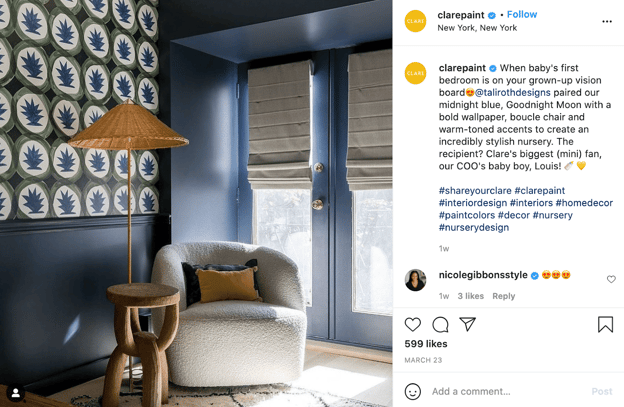
"When baby's first bedroom is on your grown-up vision board" makes the brand feel like a good-natured older (and more fashionable) sister, and the reference to the COO's baby boy is another opportunity to make authentic connections with Clare followers.
5. Skittles
Skittles often posts hilarious social media posts that strip away any promotional, phony language so you're left with something much more real.
Take a recent tweet, for instance, that reads: "Vote Skittles for Best Brand on Twitter so we can keep our jobs!"
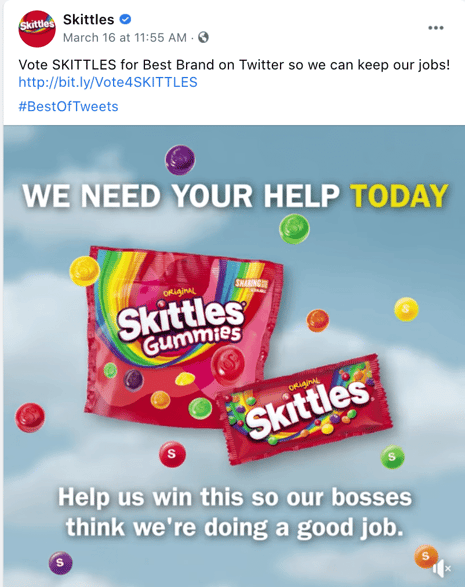
The brand voice, which is clever and original, does a good job making prospects and customers feel like they're chatting with a mischievous employee behind-the-scenes. The Oh my god, I can't believe they just posted that factor keeps the content fresh and exciting.
Plus, the brand does a good job referencing pop culture references, like this Mean Girls reference, to highlight the brand's youthfulness.
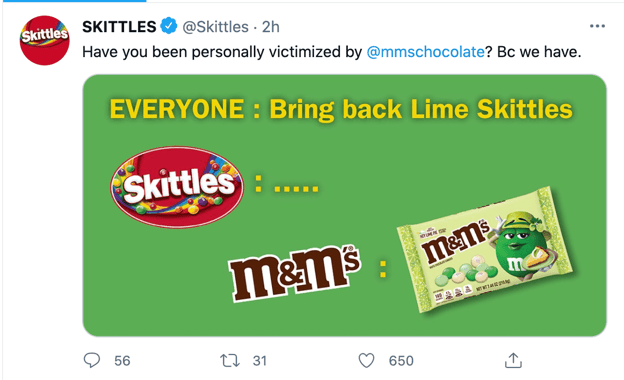
Now that we've explored five impressive examples of brand voice, let's dive into how you can create your own brand voice.
Creating a Brand Voice
1. Start with your company's mission or value statement.
Your brand's mission or value statement can help you determine some key characteristics of your brand voice.
For instance, consider A Good Company's Values page:

You'll see these values — transparency, eco-friendliness, and modern instead of traditional — embedded in every piece of content you read from A Good Company.
For instance, take a look at this blog post, Agood Recommends: The Best Second Hand and Rental Marketplaces:
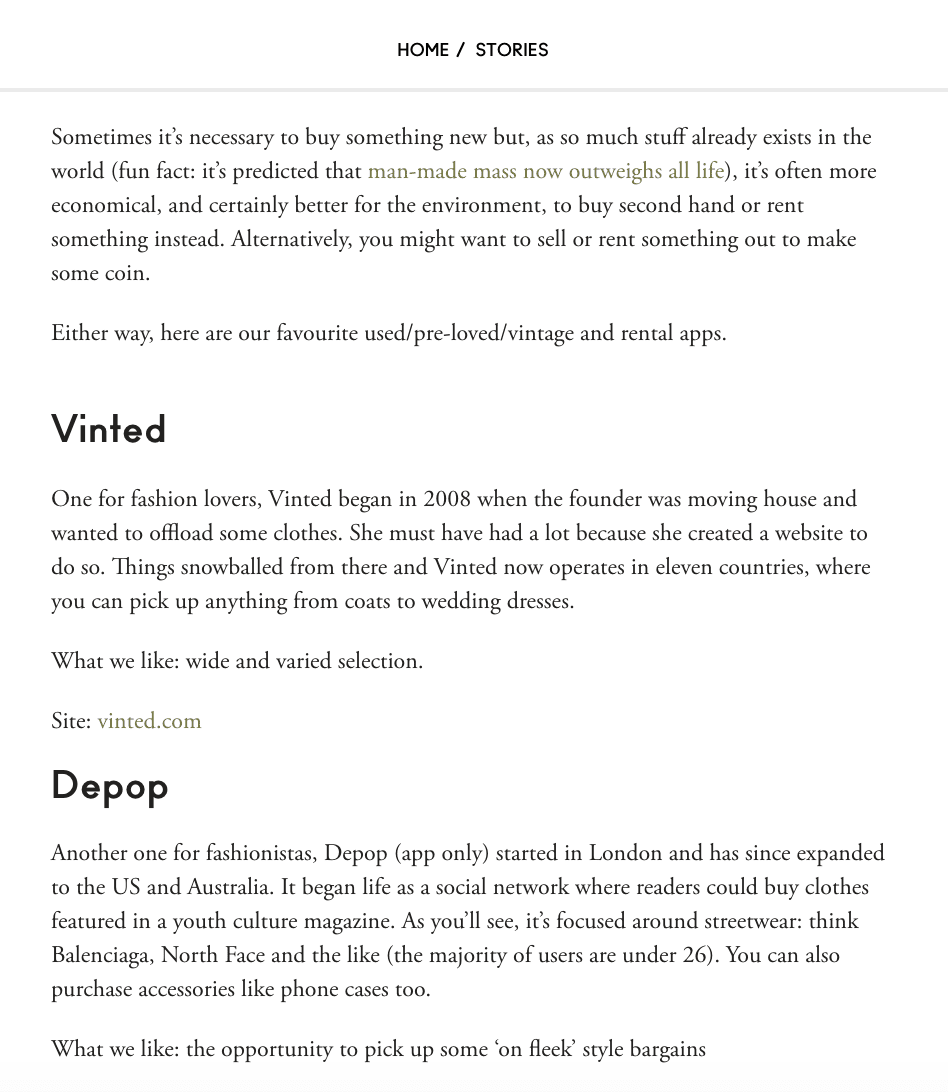
The writing is clear, straightforward, and direct, to support the brand's transparency values. The writer takes the angle of eco-friendliness in the opinions expressed throughout the piece (i.e. "so much stuff already exists in the world").
And, finally, there's a casual, informal tone to the voice, hinting at a company that isn't old-school and doesn't take itself too seriously (i.e. "pick up some 'on fleek' style bargains).
You'll want to consider your own values when creating a brand voice. Those values can become key characteristics of your voice.
2. Research your audience and use your buyer persona as inspiration for brand voice.
Your audience will be the ultimate test of whether you've created a successful brand voice. If your voice doesn't resonate with your audience, then it probably isn't the right voice.
When creating a brand voice, then, it's vital you consider your buyer persona.
What is she like? Does she like to read more formal, journalistic-style pieces, or casually skim funny memes on social media? Does she like humor in the content she consumes, or would she prefer the content be straightforward and to-the-point?
Your buyer persona will influence the voice you create.
Additionally, audience research can help you determine other types of content that perform best with your audience, which is undeniably helpful when creating a strong voice. For instance, perhaps you survey your audience or use an analytics tool like Google Analytics to determine other sites your readers frequent.
Figuring out what else they consume is helpful here — your voice should be different if your readers often consume Buzzfeed content, versus the New York Times. The Buzzfeed audience might prefer more casual, funny writing, while the latter probably likes more academic-style content.
3. Look at best-performing pieces and consider why they work.
If you've already been publishing content for a few months or even years, then take a look at your top-performing pieces and write down key characteristics of the voice used in those pieces.
Is your top-performing piece more poetic? Does it include trends and pop-culture references? Does it dive deep into a topic and include original research to back up its claims?
Ultimately, these pieces are already resonating with your audience, and it's likely (at least in part) due to voice. Take note of which aspects of the voice you feel can, and should, be replicated across your brand as a whole.
4. Make a do's and don'ts list.
Oftentimes, determining brand voice starts by asking: "What don't we want our brand voice to be?"
Figuring out what you don't want your brand voice to be is a critical step in choosing the right voice for your brand.
For instance, perhaps your team brainstorms the following statements:
- Our brand voice is not uppity or pretentious.
- Our brand voice is not too serious.
- Our brand voice is not grandiose.
- Our brand voice is not unfriendly.
Once you've taken a look at these statements, you can begin forming the antithesis to this:
Our brand voice is down-to-earth and authentic. It's funny and casual. It's humble. And it's helpful.
5. If necessary, use a third-party agency to determine brand voice.
Forbes' BrandVoice is a media partnership program that helps brands reach and resonate with their audiences through expert consultancy and direct access to Forbes audiences.
Take a look at how Cole Haan worked with Forbes to create content related to style, arts, travel, social impact, and more. Each piece uses a unique voice to target the intended audience for that category.
Consider the voice used for a staycation, travel-related piece:
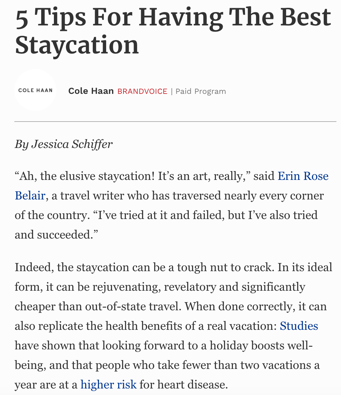
... Versus the voice used for a style-related piece that highlights a sustainable home goods company:
 As you can see, different voices are necessary for reaching and resonating with these very different audiences. And Cole Haan, with the help of Forbes' BrandVoice program, is able to use both.
As you can see, different voices are necessary for reaching and resonating with these very different audiences. And Cole Haan, with the help of Forbes' BrandVoice program, is able to use both.
If you're struggling to create a unique brand voice or you need to use different voices for different aspects of your business (like a Sales blog versus a Marketing blog), consider using a program like BrandVoice or a third-party content marketing agency to hone in on a voice that makes the most sense for your business.
6. Create a communications document so all of your content is aligned on brand voice.
Once you've created your brand voice, you'll want to ensure your entire company is aligned in using that voice when creating any marketing materials.
If your company only uses internal writers, consider creating a training course for new writers to learn how to write for your brand. If you work with external guest contributors as well, you'll want to make public-facing guest contributor guidelines to ensure all your writing captures the appropriate voice.
7. Fill out a brand voice template with 3-5 core voice characteristics.
Use a table to formalize your process. Write down the 3-5 core characteristics you've determined are important for your brand's voice, and how your writers can use these traits in their writing.
This step is important for translating ideas into action — how can your writers create a "humble, authentic voice" in their writing? Give some examples or tactical advice to make it easy for your brand voice to come through in all of your content, regardless of byline.
To explore what a template will look like in-practice, let's take a look at the following brand voice template — along with a downloadable version, so you can get started right away.
Brand Voice Template
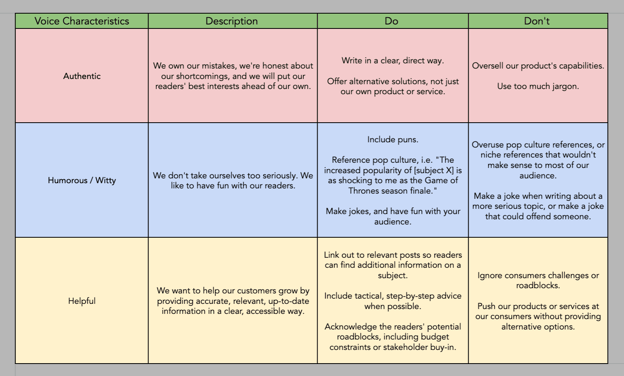
Looking to make one of these for your own brand? Click here for the blank Google Sheet template so you can copy-and-paste your own brand voice characteristics, fill out the remaining cells, and send along to your team. (It's important to note, you'll be prompted to make a Google Drive copy of the template, which isn't possible without a Google account.)
And there you have it! You're well on your way towards building a strong, compelling brand voice for your own business.
Remember: A good brand starts with good content. And good content, always, starts with voice.
from Marketing https://blog.hubspot.com/marketing/brand-voice
Whenever I'm driving and see a Herb Chambers billboard, I smile.

At this point, I can recognize the short, humorous, memorable ad copy as a Herb ad without even needing to see the brand name.
And, after years of seeing those ads, I feel like I know the Herb brand, and can describe it like an old friend: He's funny, likes a good pun, and doesn't take himself too seriously.
Now that's the power of brand voice: the power to make your brand come to life.
Consumers prefer brands with strong, unique personalities. In Sprout Social's 2020 Index, for instance, 40% of consumers listed memorable content as a factor that helps brands stand out on social; 33% voted for distinct personality; and 32% said compelling storytelling.
What do memorable content, distinct personality, and compelling storytelling have in common? Brand voice.
Here, let's explore what brand voice is, and examples of some of the most powerful brand voices today. Plus, how you can create your own.
What is brand voice?
When a friend calls you, consider — beyond the name that appears on caller ID — how do you know it's her?
More likely than not, you can deduce this information from how she speaks. The common phrases she uses, how she tells a story, her tone and inflection, and even what information she chooses to include (and exclude) in a given sentence all highlight her unique voice and personality.
Alternatively, think about the last time you chatted with a stranger. In mere minutes, I bet you start to get a sense for their personality. Through a brief conversation, you can start to deduce whether they're outgoing or shy, serious or funny, and more.
Ultimately, a person's voice is synonymous with their personality, as it relates to how they communicate.
And brand voice isn't much different.
Brand voice is the personality your brand takes on in all of its communications.
Brand voice is a critical factor for creating consistency across communication channels, regardless of who creates the content. For instance, brands with strong voice will sound the same on social media, email communications, and blog posts — even if three different teams create content for those channels.
Good brand voice makes your brand stand out from the noise, and helps consumers remember and relate to your brand. This, in turn, creates stronger brand loyalty.
Plus, brand voice can help attract new prospects before they even learn about your product or services.
For instance, consider the humor used in MoonPie's social posts:

Before I'd even purchased a MoonPie for the first time, I followed them on Twitter. Why? Because I liked the brand's voice — it made me laugh, and felt relatable.
Of course, a brand voice doesn't have to be funny to be powerful. Other powerful brand voices can be inspiring, emotional, bold, casual, formal, poetic, or direct.
To see this in-action, let's take a look at some impressive examples of brand voice, next.
Brand Voice Examples
1. Spotify
Whether you're watching a TV ad, driving past a billboard, or scrolling Spotify's social accounts, you'll see consistently funny, edgy, direct, and concise language used to develop Spotify's brand voice.
For instance, take a look at this video, which is part of a Spotify advertisement campaign from 2019, 'Let the Song Play':
As you can see, Spotify doesn't take itself too seriously. The ad makes fun of people who get so emotionally-invested in a song that they won't resume their plans until the song ends.
You'll see a similar brand voice play out on Spotify's social channels. On its Twitter account, for instance, the brand often posts tweets related to new music in a casual, friendly manner, like this one:

If I were to describe Spotify's brand voice as a person, I'd say she's witty, sarcastic, and up-to-date on today's pop culture references. You'll see that personality play out across all of Spotify's communication channels.
2. Mailchimp
For this next example, we can look at Mailchimp's Content Style Guide to derive important information related to Mailchimp's brand voice.
In the Style Guide, Mailchimp writes, "We want to educate people without patronizing or confusing them. Using offbeat humor and a conversational voice, we play with language to bring joy to their work … We don't take ourselves too seriously."

Even in the Style Guide, you can hear Mailchimp's brand voice shine through. The brand consistently achieves a conversational, direct, playful voice in all its content.
For instance, in this blog post, the brand writes about various "highly unscientific personas", including the fainting goat, which links out to a hilarious video. "When startled, its muscles stiffen up and it falls right over", strikes the appropriate casual tone that is a staple of the brand's voice.
As you can see from this example, you can evoke brand voice in subtle yet effective ways. If the blogger had instead written, "If a goat is scared, it becomes nervous. The animal's muscles contract and it faints as a result", the writer would've evoked a voice more aligned with a scientific journal than Mailchimp.

3. Fenty Beauty
On the About Us page for Rihanna's beauty company, it says, "Before she was BadGalRiRi: music, fashion and beauty icon, Robyn Rihanna Fenty was a little girl in Barbados transfixed by her mother’s lipstick. The first time she experienced makeup for herself, she never looked back. Makeup became her weapon of choice for self-expression."
It's clear, even just through this short snippet, that Fenty Beauty's voice is bold, direct, and poetic, using language like "transfixed by her mother's lipstick" and "her weapon of choice for self-expression". However, the tone is also undeniably casual — the way you might talk to your best friend.

You'll see this voice play out across all Fenty social channels, including this YouTube video description: "The blur is REAL! Rihanna wanted to create a light coverage, easy-to-apply, flexible skin tint that instantly evens out your complexion and gives a flattering blurred effect. Eaze Drop, paired with Fenty Skin's HYDRA VIZOR for added SPF protection, is the perfect combo for a natural, no-makeup makeup look, or for when you want to look effortlessly put together."
The first statement, "The blur is REAL!" — along with phrases like "No-makeup makeup look", and the shortening of the word "combination" — all evoke a sense of friendliness. The brand voice matches its target audience perfectly: youthful millennials and Gen-Zers who care about makeup as an opportunity for authentic expression.

4. Clare Paint
Clare, an online paint site, has created a mature, spirited, and cheerful brand voice to evoke a breezy, girl-next-door feel to their branded content.
For instance, consider the title of one of their recent blog posts, "6 Stylish Rooms on Instagram That Make a Strong Case For Pink Walls".
The post — which uses phrases like "millennial pink", "pink walls have obvious staying power", and "designers and DIY enthusiasts alike have embraced the playful shade with open arms" — uses a friendly, chic, professional tone to relate to its readers while simultaneously demonstrating the brand's home decor expertise.

This voice is clear across channels. Take a look at this Instagram post, for instance:

"When baby's first bedroom is on your grown-up vision board" makes the brand feel like a good-natured older (and more fashionable) sister, and the reference to the COO's baby boy is another opportunity to make authentic connections with Clare followers.
5. Skittles
Skittles often posts hilarious social media posts that strip away any promotional, phony language so you're left with something much more real.
Take a recent tweet, for instance, that reads: "Vote Skittles for Best Brand on Twitter so we can keep our jobs!"

The brand voice, which is clever and original, does a good job making prospects and customers feel like they're chatting with a mischievous employee behind-the-scenes. The Oh my god, I can't believe they just posted that factor keeps the content fresh and exciting.
Plus, the brand does a good job referencing pop culture references, like this Mean Girls reference, to highlight the brand's youthfulness.

Now that we've explored five impressive examples of brand voice, let's dive into how you can create your own brand voice.
Creating a Brand Voice
1. Start with your company's mission or value statement.
Your brand's mission or value statement can help you determine some key characteristics of your brand voice.
For instance, consider A Good Company's Values page:

You'll see these values — transparency, eco-friendliness, and modern instead of traditional — embedded in every piece of content you read from A Good Company.
For instance, take a look at this blog post, Agood Recommends: The Best Second Hand and Rental Marketplaces:

The writing is clear, straightforward, and direct, to support the brand's transparency values. The writer takes the angle of eco-friendliness in the opinions expressed throughout the piece (i.e. "so much stuff already exists in the world").
And, finally, there's a casual, informal tone to the voice, hinting at a company that isn't old-school and doesn't take itself too seriously (i.e. "pick up some 'on fleek' style bargains).
You'll want to consider your own values when creating a brand voice. Those values can become key characteristics of your voice.
2. Research your audience and use your buyer persona as inspiration for brand voice.
Your audience will be the ultimate test of whether you've created a successful brand voice. If your voice doesn't resonate with your audience, then it probably isn't the right voice.
When creating a brand voice, then, it's vital you consider your buyer persona.
What is she like? Does she like to read more formal, journalistic-style pieces, or casually skim funny memes on social media? Does she like humor in the content she consumes, or would she prefer the content be straightforward and to-the-point?
Your buyer persona will influence the voice you create.
Additionally, audience research can help you determine other types of content that perform best with your audience, which is undeniably helpful when creating a strong voice. For instance, perhaps you survey your audience or use an analytics tool like Google Analytics to determine other sites your readers frequent.
Figuring out what else they consume is helpful here — your voice should be different if your readers often consume Buzzfeed content, versus the New York Times. The Buzzfeed audience might prefer more casual, funny writing, while the latter probably likes more academic-style content.
3. Look at best-performing pieces and consider why they work.
If you've already been publishing content for a few months or even years, then take a look at your top-performing pieces and write down key characteristics of the voice used in those pieces.
Is your top-performing piece more poetic? Does it include trends and pop-culture references? Does it dive deep into a topic and include original research to back up its claims?
Ultimately, these pieces are already resonating with your audience, and it's likely (at least in part) due to voice. Take note of which aspects of the voice you feel can, and should, be replicated across your brand as a whole.
4. Make a do's and don'ts list.
Oftentimes, determining brand voice starts by asking: "What don't we want our brand voice to be?"
Figuring out what you don't want your brand voice to be is a critical step in choosing the right voice for your brand.
For instance, perhaps your team brainstorms the following statements:
- Our brand voice is not uppity or pretentious.
- Our brand voice is not too serious.
- Our brand voice is not grandiose.
- Our brand voice is not unfriendly.
Once you've taken a look at these statements, you can begin forming the antithesis to this:
Our brand voice is down-to-earth and authentic. It's funny and casual. It's humble. And it's helpful.
5. If necessary, use a third-party agency to determine brand voice.
Forbes' BrandVoice is a media partnership program that helps brands reach and resonate with their audiences through expert consultancy and direct access to Forbes audiences.
Take a look at how Cole Haan worked with Forbes to create content related to style, arts, travel, social impact, and more. Each piece uses a unique voice to target the intended audience for that category.
Consider the voice used for a staycation, travel-related piece:

... Versus the voice used for a style-related piece that highlights a sustainable home goods company:
 As you can see, different voices are necessary for reaching and resonating with these very different audiences. And Cole Haan, with the help of Forbes' BrandVoice program, is able to use both.
As you can see, different voices are necessary for reaching and resonating with these very different audiences. And Cole Haan, with the help of Forbes' BrandVoice program, is able to use both.
If you're struggling to create a unique brand voice or you need to use different voices for different aspects of your business (like a Sales blog versus a Marketing blog), consider using a program like BrandVoice or a third-party content marketing agency to hone in on a voice that makes the most sense for your business.
6. Create a communications document so all of your content is aligned on brand voice.
Once you've created your brand voice, you'll want to ensure your entire company is aligned in using that voice when creating any marketing materials.
If your company only uses internal writers, consider creating a training course for new writers to learn how to write for your brand. If you work with external guest contributors as well, you'll want to make public-facing guest contributor guidelines to ensure all your writing captures the appropriate voice.
7. Fill out a brand voice template with 3-5 core voice characteristics.
Use a table to formalize your process. Write down the 3-5 core characteristics you've determined are important for your brand's voice, and how your writers can use these traits in their writing.
This step is important for translating ideas into action — how can your writers create a "humble, authentic voice" in their writing? Give some examples or tactical advice to make it easy for your brand voice to come through in all of your content, regardless of byline.
To explore what a template will look like in-practice, let's take a look at the following brand voice template — along with a downloadable version, so you can get started right away.
Brand Voice Template

Looking to make one of these for your own brand? Click here for the blank Google Sheet template so you can copy-and-paste your own brand voice characteristics, fill out the remaining cells, and send along to your team. (It's important to note, you'll be prompted to make a Google Drive copy of the template, which isn't possible without a Google account.)
And there you have it! You're well on your way towards building a strong, compelling brand voice for your own business.
Remember: A good brand starts with good content. And good content, always, starts with voice.


No hay comentarios:
Publicar un comentario